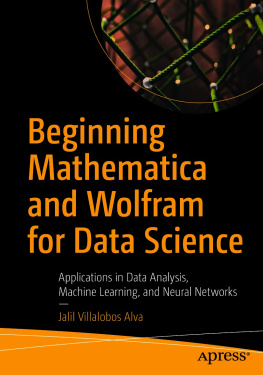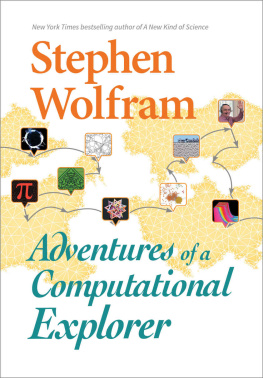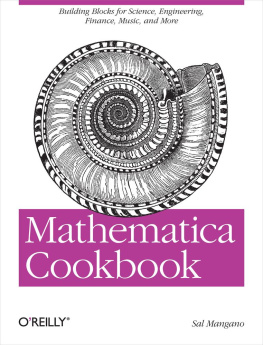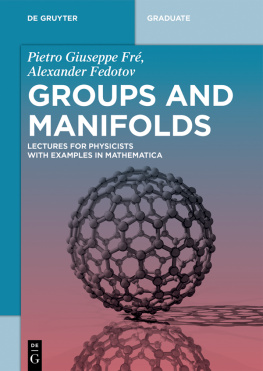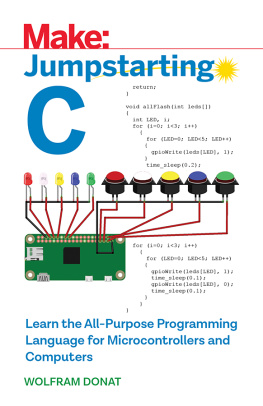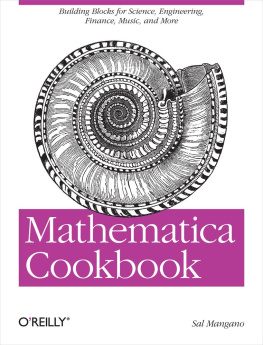Contents

MATHEMATICA
BEYOND MATHEMATICS
THE WOLFRAM LANGUAGE
IN THE REAL WORLD
MATHEMATICA
BEYOND MATHEMATICS
THE WOLFRAM LANGUAGE
IN THE REAL WORLD
Jos Guillermo Snchez Len
Universidad de Salamanca, Spain

CRC Press
Taylor & Francis Group
6000 Broken Sound Parkway NW, Suite 300
Boca Raton, FL 33487-2742
2017 by Taylor & Francis Group, LLC
CRC Press is an imprint of Taylor & Francis Group, an Informa business
No claim to original U.S. Government works
Printed on acid-free paper
Version Date: 20170202
International Standard Book Number-13: 978-1-4987-9629-3 (Hardback)
This book contains information obtained from authentic and highly regarded sources. Reasonable efforts have been made to publish reliable data and information, but the author and publisher cannot assume responsibility for the validity of all materials or the consequences of their use. The authors and publishers have attempted to trace the copyright holders of all material reproduced in this publication and apologize to copyright holders if permission to publish in this form has not been obtained. If any copyright material has not been acknowledged please write and let us know so we may rectify in any future reprint.
Except as permitted under U.S. Copyright Law, no part of this book may be reprinted, reproduced, transmitted, or utilized in any form by any electronic, mechanical, or other means, now known or hereafter invented, including photocopying, microfilming, and recording, or in any information storage or retrieval system, without written permission from the publishers.
For permission to photocopy or use material electronically from this work, please access www.copyright.com (http://www.copyright.com/) or contact the Copyright Clearance Center, Inc. (CCC), 222 Rosewood Drive, Danvers, MA 01923, 978-750-8400. CCC is a not-for-profit organization that provides licenses and registration for a variety of users. For organizations that have been granted a photocopy license by the CCC, a separate system of payment has been arranged.
Trademark Notice: Product or corporate names may be trademarks or registered trademarks, and are used only for identification and explanation without intent to infringe.
Visit the Taylor & Francis Web site at
http://www.taylorandfrancis.com
and the CRC Press Web site at
http://www.crcpress.com
About Mathematica and the Wolfram Language
If you have used Mathematica occasionally or heard of it, you may have the false impression that it is a program for performing complicated calculations, usually for academic purposes. However, this idea is far from the truth. Actually, Mathematica is much more than that. By putting together the computational power and ease of use of the Wolfram Language, Mathematicas high-level general-purpose programming language, the program can be used in any scientific or technical field: Aerospace engineering, environmental sciences, financial risk management, medical imaging and many others. (You can get an idea by visiting: http://www.wolfram.com/solutions).
Mathematica can be considered a tool that empowers non-professional programmers to develop applications although if you are a professional programmer, you will see that the software provides a development environment similar to the ones available for C++ or FORTRAN. You can even use the program to control external devices.
About the Book
Although many books have been written about Mathematica, very few of them cover the new functionality added to the most recent versions of the program. This text introduces the new features using real-world examples, based on the experience of the author as a consultant. In the process, you will also learn more about the Wolfram Language and how you can use it to solve a wide variety of problems. Both are the most important objectives of the book. To accomplish that, the author raises questions from a wide range of topics and answers them by taking full advantage of Mathematicas latest features. For example: What is the hidden image in The Ambassadors painting by Holbein? What sources of energy does the world really use? How can we calculate tolerance limits in manufacturing processes? Are our cities getting warmer? Is the novel El Quijote written in Pi? How do we know how old our planet is? How can we find planets outside our solar system? How big is our galaxy? And the universe? How do we know it? How can we model the distribution of radioactive isotopes in the human body? And a tsunami? What are and how can we create Mandelbrot fractals? How can we measure the genetic distance between species? How can we perform financial calculations in real time? How do we value financial derivatives? How can we make entertaining simulations for teaching mathematics, physics, statistics, ... ? Why are there no free quarks?
The answers to the previous questions will not only help you master Mathematica, but also to become more familiar with the corresponding topics themselves.
About the Book Objectives
This book will not only be useful to newcomers but also to those familiar with the program and interested in learning more about the new functionality included in the latest versions.
Those readers with minimal or no knowledge of Mathematica are strongly advised to read along with Stephen Wolframs book An Elementary Introduction to the Wolfram Language available from within the program documentation: HelpWolfram DocumentationIntroductory Book
This text will also make it easy to start programming using the Wolfram Language and to learn how to take full advantage of its capabilities.
The final objective of Mathematica Beyond Mathematics is to help you avoid feeling overwhelmed by the softwares vast capabilities. The author has explored a significant part of them choosing the most relevant parts and illustrating them with examples from many different sources including the program documentation. Links to additional resources will also be provided. The main aim of all this is to reduce significantly the amount of time required to master the tool. The commands used will be explained using short sentences and simple examples.
About the Use of the Book
Although this book is not a manual, inexperienced readers should at least read the first four chapters in consecutive order to gain a solid understanding of how Mathematica works. Regarding the rest of the chapters, you should keep in mind the following: a) is for those readers facing problem requiring big computational resources (parallel computing, grid-enabled calculations, etc.) and/or the ones interested in other programs related to Mathematica such as webMathematica for adding computational capabilities to websites or Workbench, a complete software development environment using the Wolfram Language.
The principal theme of each chapter is used as the motivation to illustrate certain features of Mathematica that you may find useful for solving a great variety of problems. For example: , covering the modeling of biological systems, discusses the resolution of differential equations in


